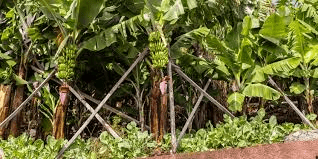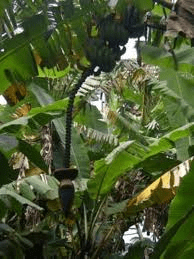The heavy weight of the plantain bunch bends all bearing plants and can cause doubling (pseudo stem breaks), snap- off (corm breaks, leaving a part in the ground) or uprooting, also called tip-over (the entire corm with roots comes out of the ground).
Propping can simply be defined as a cultural operation of plantain / banana plant which give additional support of the plant , which bear heavy load during bunching (flower perod).
Plants are generally weak during the dry season and strong winds, nematodes and stem borers also increase the rate of loss. For these reasons, bearing plants always need support from 1 or 2 wooden props, usually made of bam- boo.
If a piece of bamboo is used, the support is placed alongside the bearing plant and the top of the plant is tied to the bamboo. A lateral branch at the top of the bamboo prop sometimes forms a natural fork which can be used to support the plantain without being tied to it.
When 2 pieces of bamboo are used, the bunch and not the plant is supported in the first place. The bamboo props are crossed and form a fork. This fork is tied together with a rope and placed just underneath the bunch.
Meanwhile at the time of bunch emergence , pseudostem requires support from props. Tall varieties which produce heavy bunches need propping. Bamboo or casuarinas poles which have effective life of 3-4 years are commonly used for propping. Coir or polythene wire can also be used for propping.
Read Also: Introduction and Morphology of Plantain
Plantain however can be grown together with other types of compatible crops (cocoa, cocoyam) or as a single crop.
According to research, Bananas (Musa spp.), includingdessert banana, plantainand cooking banana are the eighth most important food crop in the world, and the fourth most important inleast developed countries.
They are produced in 135 countries and territories across the tropics and subtropics. The vast majority of producers are smallholder farmers who grow the crop for either home consumptionor local markets. Less than 15 per centof the global production of more than 130 million metric tons is exported. Today, the international banana trade, totaling around 17 million metric tons, is worth over US$7 billion per year (FAOSTAT).
This makes venturing into a plantain plantation / plantain farming very lucrative. Africa produces one-third of all bananas and plantains in the world. In West and Central Africa these are plantains while in Eastern Africa these are highland cooking and beer bananas. There are about 120 plantain varieties and 70 highland bananas. All suffer from nematodes, weevils,and black Sigatoka.
Read Also: Managing the Fallow Period in Plantains
Now away from plantain / banana propping, let us have a look at the recommended systems of planting your plantains and bananas for maximum yield and profits below:
Recommended Systems of Planting Plantains / Bananas

1) Single row system
- In single row planting, the distance within the row is close, whereas the distance between the row is wide.
- This system allows good aeration to plant canopy, allowing wet leaves to dry more rapidly, reducing fungal disease severity.
- In this, less number of trees occupied in the field and yield will automatically reduced .
2) Paired Row System
- In this method, the distance between the two lines is 0.90 to 1.20 m. while plant to plant distance is 1.2 to 2 m.
- Due to this spacing, intercultural operations can be carried out easily and cost of drip irrigation is decreased.
3) Square System
- This is the most commonly followed system and is very easy to layout.
- Banana is mostly cultivated by adopting 1.8×1.8m spacing
- In this system, trees are planted on each comer of a square whatever may be the planting distance.
- The central place between four trees may be advantageously used to raise short lived filler trees.
- This system permits inter cropping and cultivation in two directions.
4) Triangular System
- This system is best suited for tissue culture banana suckers.
- In this, adopt spacing in between rows was 1.5m and plant to plant was 1.8m in the row.
- The trees are planted as in square system but the difference being that those in the even numbered rows are midway between those in the odd rows instead of opposite to them.
- The distance between any two adjacent trees in a row is equal to the perpendicular distance between any two adjacent rows.
- When compared to square system, each tree occupies more area and hence it accommodates few trees per hectare than the square system.
Recommended Methods of Planting Plantains / Bananas

- Pit Method
- Furrow Method
- Trench Planting
1) Pit Method
- Pit planting is commonly followed in garden land system of cultivation. Pits of 60 cm x 60 x 60 cm x 60 cm size are dug, filled with a mixture of soil, sand and FYM (Farm Yard Manure) in a 1:1:1 ratio. Suckers are planted in the centre of the pit and soil around is compacted.
- Planting is done from February to May whereas in North India, it is done during July-August. In South-India, it can be done any time of year except summer.This is mostly followed in biennial plantations for Dwarf Cavendish, Rasthali, Robusta, Poovan and Karpuravalli banana.
- However this method is very laborious and expensive. The only advantage is that no earthing up is required as planting is done at the required depth. This practice is not very popular at present.
2) Furrow Method
- In Gujarat and Maharashtra, furrow planting is practiced. After land preparation, 30-40 cm deep furrows are made, either manually or with a ridger.
- Suckers are placed at required spacing; FYM is applied around, mixed with soil and tightly packed round the suckers.
- Furrow planting is practised in annual panting system. In this method earthing up needs to be frequently done to cover the exposed rhizomes.
Read Also: Weed Control Methods for Plantain Plantations
3) Trench Planting
- Trench planting is practised in wet land cultivation of Cauvery delta region of Tamil Nadu. Land is prepared like paddy using plenty of water and gauge wheel.
- Water is drained from the field allowing setting for a day. Planting is done by simple pressing the suckers into the wet field.
- After a week 15 cm deep trenches are opened both ways maintaining 4 or 6 plants in each block.
- Deepening of trenches by 20-25 cm is taken up every month after planting till suckers put forth 1-3 leaves.
- During third month trenches are broadened and deepened to 60 cm. in rainy season some trenches are used as drainage channels. After about 2 months, trenches are cleaned; decayed manure is used for plants for organic cycling.
High Density Planting (HDP)

- High Density Planting (HDP) is normally refers to planting at a spacing than the usual recommended spacing.
- Choosing the correct planting density is very important for bridging the gap between the actual yield and the potential yield of banana from a unit area.
- For the highest possible yields of good quality fruit, there is an optimum plant density, which should be maintained for sustaining the economic life of the plantation.
- This optimum varies with the location, cultivator, soil fertility, management level and economic considerations.
- These factors in turn influence more specific determinants of density choice such as prevailing climate, plantation vigour and its longevity.
Plant canopy and light intersection
- Unlike other fruits, the vegetative growth, flowering and fruit growth is not seasonal in banana and are largely influenced by time of planting, type and size of planting material and prevailing temperature.
- Planting density and their interception. Reduced light intensity at ground level with increase in size energy conversion efficiency was maximum in 1.2 x 1.2m spacing and minimum in 2.1 x 2.1m spacing.
Read Also: Mulching of Plantains and the Advantages
Plant height and girth
- Height of pseudostem is invariably increased with reduction in spacing.
- Plant height is adversely influenced, depending upon cultivators.
- Stem girth is reduced with height on increase in density.
- Girth of Robusta banana was not influenced by varying plant density although tallest plants were produced under closer spacing of 1.2 x 1.2 m.
- In poovan cultivar, palnt height was significantly increased and grith reduced when spacing was brought down from 2.1 x 2.2m to 1.5 x 1.8m.
Leaf number and leaf area index
Canopy characteristics such as leaf area index (LAI) and transmission of photosyntheically Active radiation (PAR) can be used to correlate with optimum density.
Leaf emergence is reduced under very close planting owing to lower temperature inside the canopy since temperature had significant influence on rate of leaf emergence.
Sucker production and root growth
- The number of suckers per plant was more in wider spacing compared to that in closer to that in closer spacing.
- The suckers per plant decreased with reduction in planting distance with reduction in planting distance in Robusta and Poovan.
- The length of fine roots increased with increase in plant density to shooting and declined thereafter.
Read Also: Why Every New Parent Needs a Baby Carrier
Frequently Asked Questions
We will update this section soon.
